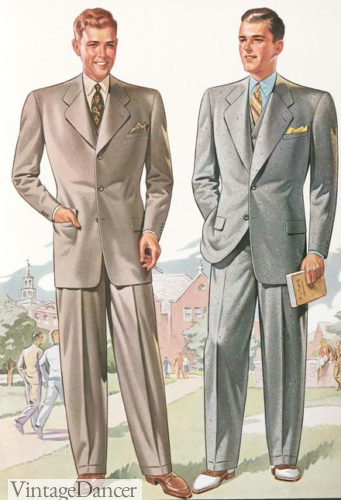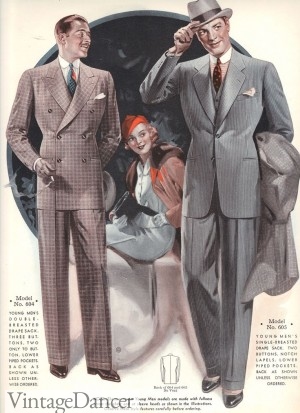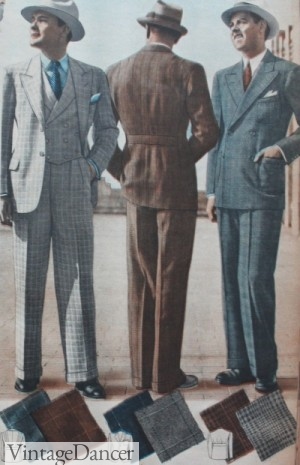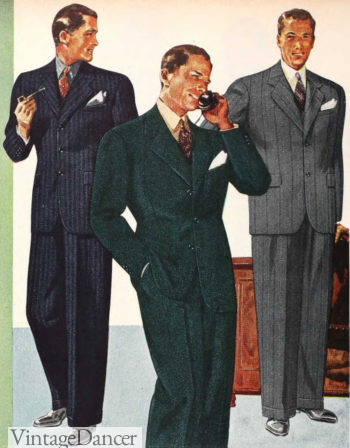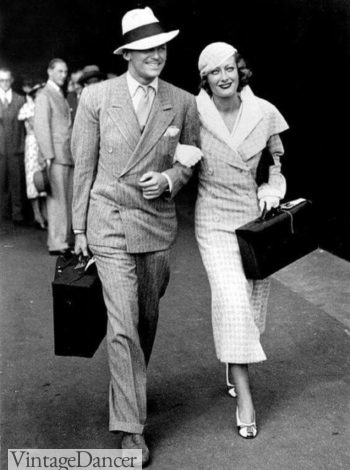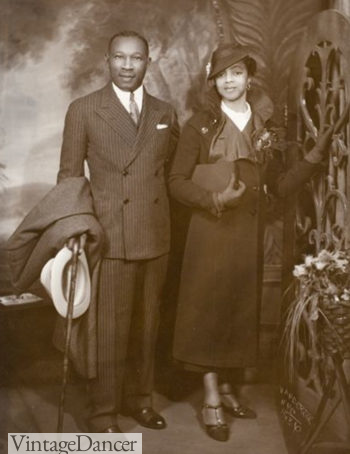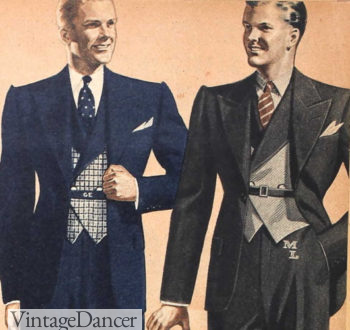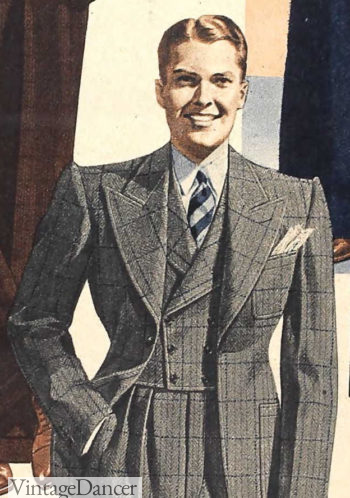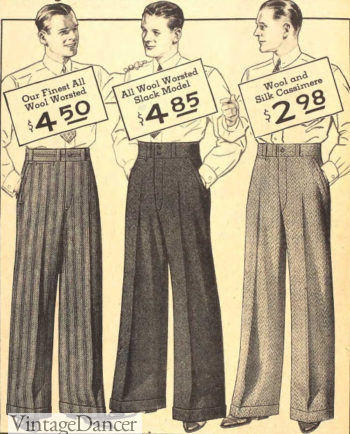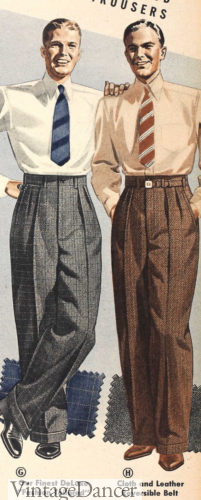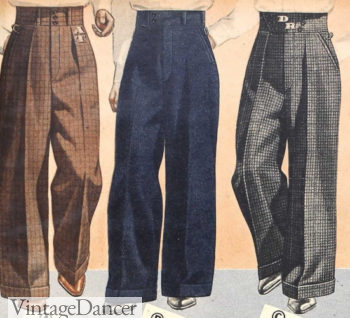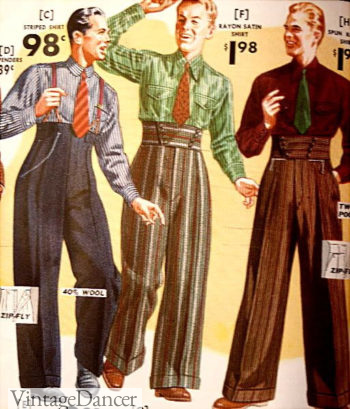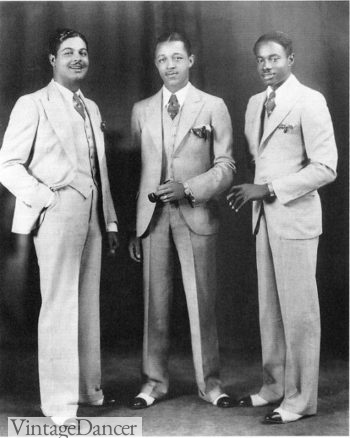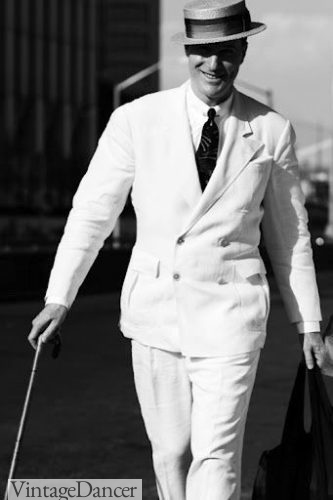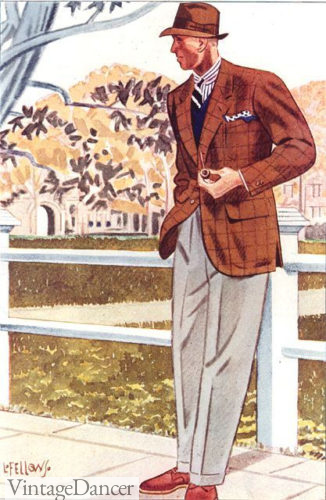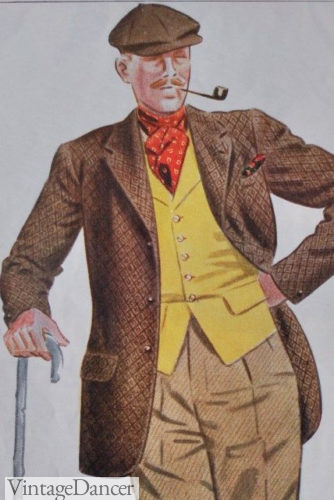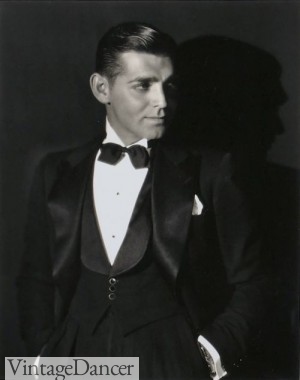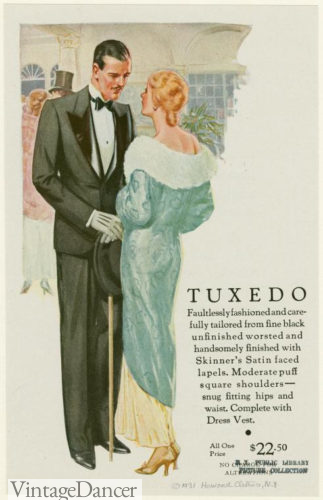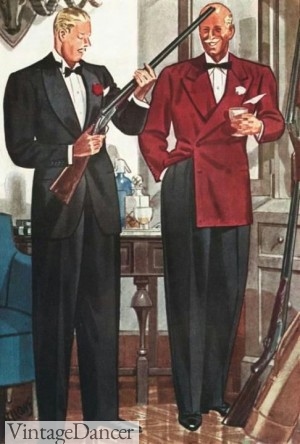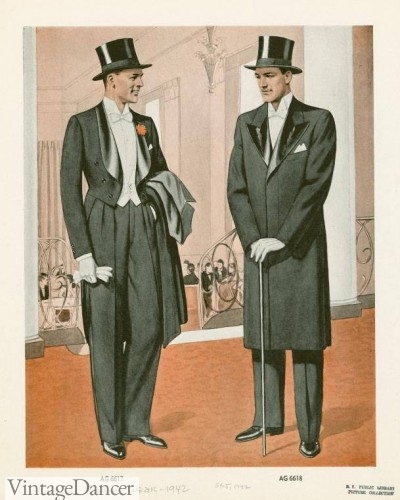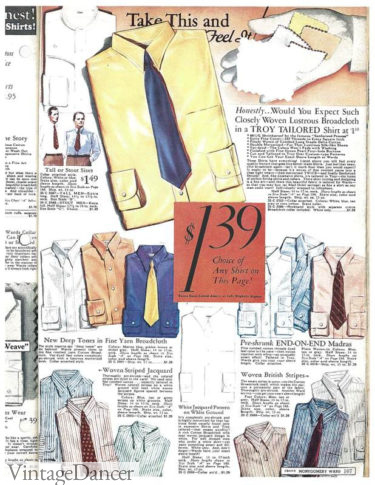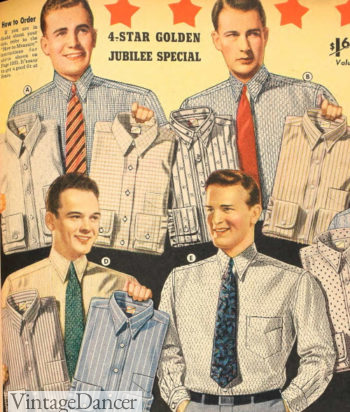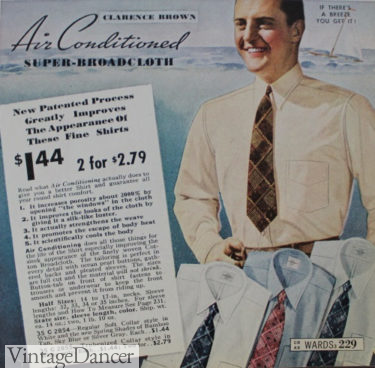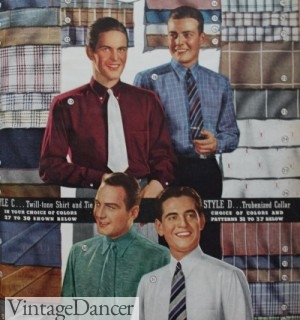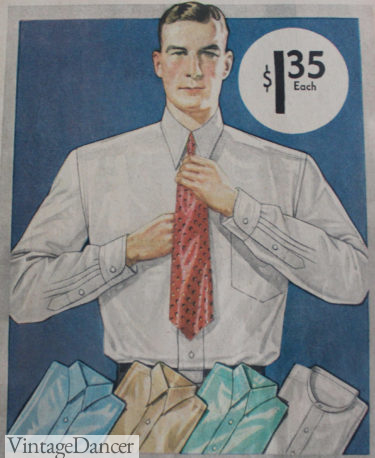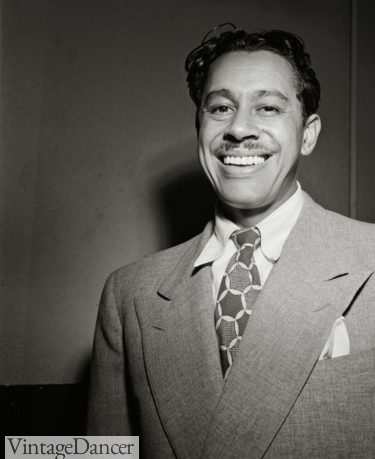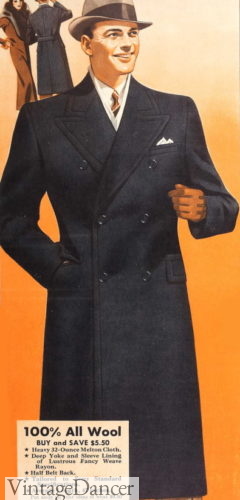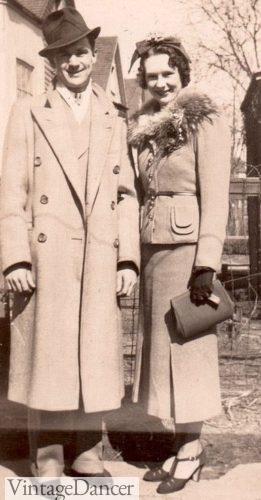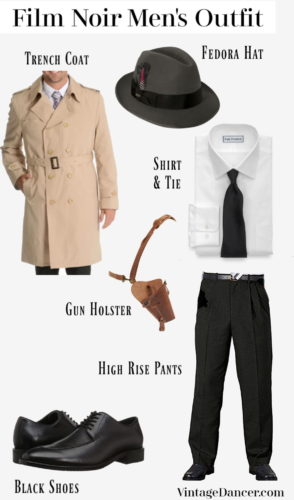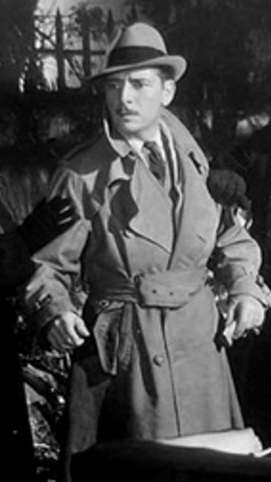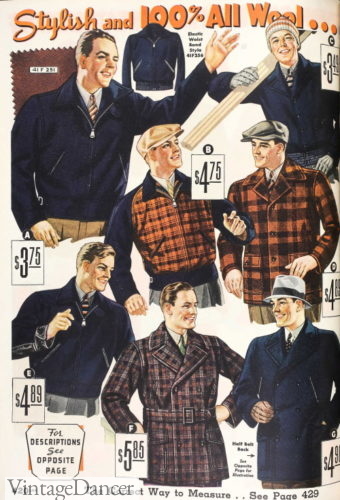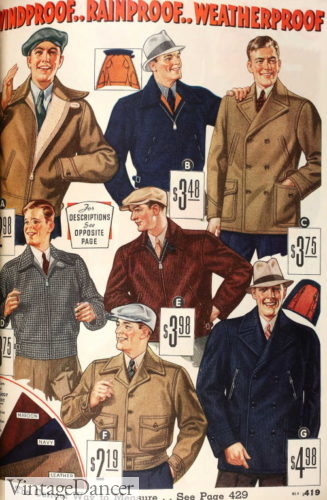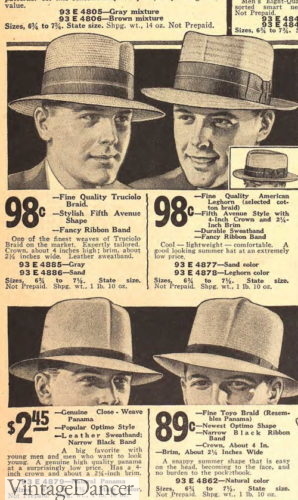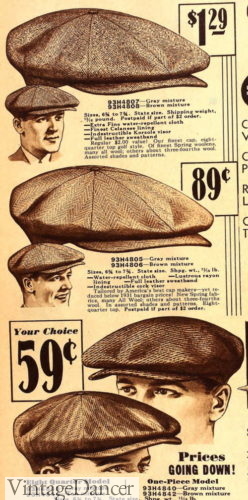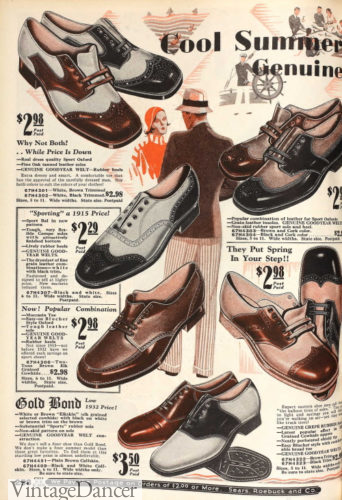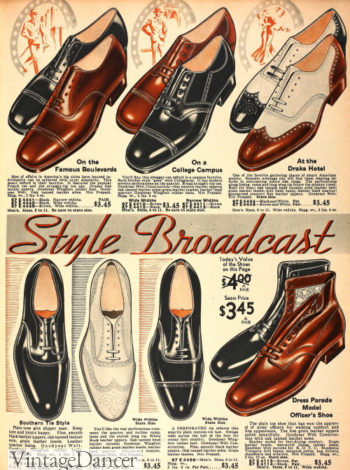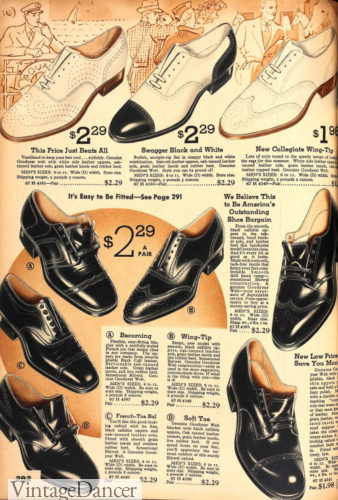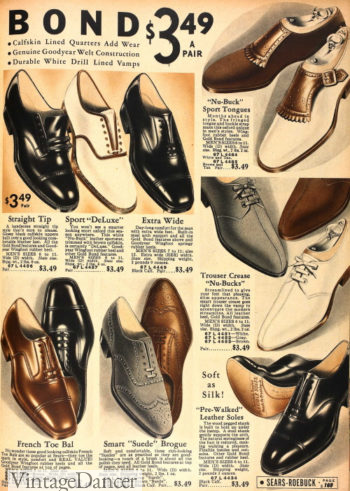Men’s 1930s fashion is often considered the finest men’s fashion in the past century – and for good reason.
The 1930s were a turbulent decade where the free-spirited, reckless, youthful “me” class of the roaring twenties was replaced by serious, masculine, working-class men who had responsibilities to their home and country. The stock market crash of 1929 not only put men out of work, but also out of reach of high fashions coming from Europe. The new man of the 1930s was conservative yet colorful, oversized yet practical, and confident yet concerned about his spending on unnecessary clothing. His “larger than life” look spoke to his optimism for a recovering economy and his role as the patriarchal head of household.
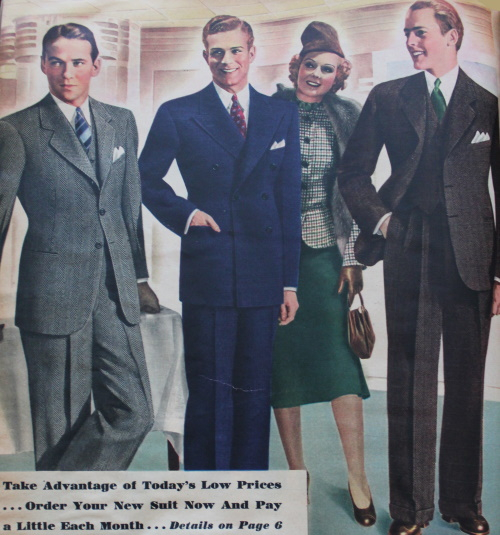
1938 Men’s Suit Fashions
In the 1930s, the athletic body seen on boxers, swimmers, and Superman became the ideal male figure. Clothing reflected this new silhouette with extra broad shoulders, thin waists, and tapered wide legs. Everything was big, tall, and surprisingly comfortable, as the looseness of clothing made it easier than ever to work and play — and working and playing was about all men did.
Long hours working laborious jobs meant enjoying what leisure time they had was all the more important. There continued to be an increase in playing sports (not just watching them), vacationing (camping and beaches), and going to the movies, where the leading men of the silver scene cruised the world in style, solved murder mysteries, and won the heart of a beautiful but helpless lady.
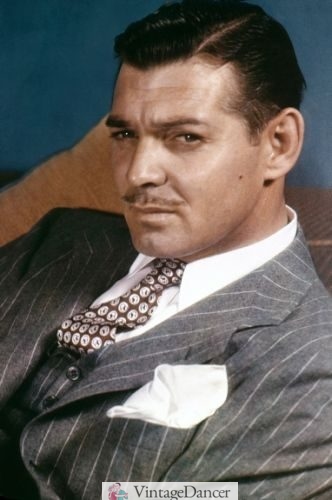
1938 Clark Gable in a Pinstripe Suit
1930s Men’s Suits
With the exception of labor workers or uniformed servicemen, men wore a suit from the moment they got dressed to the moment they returned back home. Suits could be formal or casual depending on the cut, material, and color, as well as the time of day and occasion they were dressing for.
1930s men’s suits colors favored medium blue, tans, beige, cream, golden browns, and many shades of grey in spring and summer. Fall and winter featured navy blue, medium brown, and dark grey tones. Besides color, the 1930s man wore suits with distinctive patterns. Bold patterns such as large plaids, windowpane, chalk stripes, checks, and herringbone appeared in every color year-round. Glenn Plaid or Glen Urquhart check was the most popular suit pattern in the 1930s. Chine, birdseye, vertical stripes, and diagonal stripes were also common spring and summer weaves.
The difference between ’30s patterns and ‘20s patterns was the overall tone. The 1920s loved clashing colors in their patterns, while the 1930s were more subtle with lighter or darker shades of the primary color. For example, a light grey plaid suit would have medium grey lines. In the 1920s, those lines might have been blue, green, or brown.
- 1931 Men’s “University” Style Suits
- 1935 Single and Double-Breasted Suits
- 1937 Men’s Suits for Spring
- 1939 Classic Men’s Suits
1930s suits were cut to add the illusion of both height and width. Suit jackets were long with wide padded shoulders and wide rolled notch or peak lapels. Peak lapels stretched out a bit further in the ’30s with an angled tip upwards, and the jacket nipped in at the upper waist before skirting out over the full hip. The double-breasted suit was especially good at adding width to the thin man. Portly men looked better with a box-back jacket, with or without center seams to allow for more movement.
- Douglas Fairbanks was Fond of the Double Breasted Suit
- An Elegant Pinstripe Double Breasted Suit and Ladies’ Coat
Suit jacket backs came in two styles. The belted back was a sportier carryover style from previous decades, while the ventless back was a newer, smoother, and length-enhancing jacket that was also more affordable.
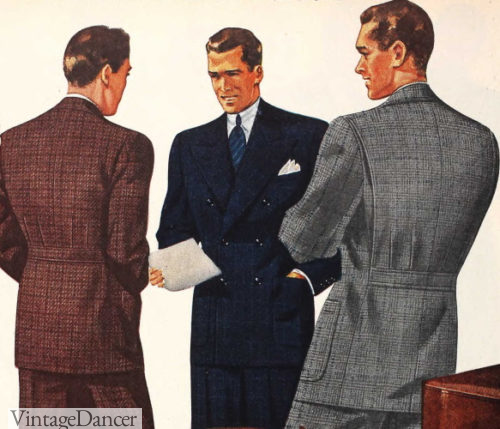
1939 Belted Back Suits
Most suits came with a matching 5 or 6 button vest, with or without lapels and four slit pockets. Most were single-breasted vests, but a few still chose the more formal double-breasted waistcoat with two pockets. There was a trend among the young collegiate men for the two-tone double-breasted vest with belt, as well as the straight-hem vest with high waisted British trousers.
- 1938 Belted Vest
- 1938 Straight-Hem Double Breasted Vest
Suit pants fit high on the waist, bulged out over the thigh and knee, and tapered slightly down to the ankle, usually with a cuff. Leg widths were about 22 inches at the cuff. Pleats at the waistband allowed more fabric to drape down, creating a baggy effect. Non-pleat pants were equally popular and better at creating a smooth lean look. A single pressed line down the center of the leg (both front and back) added to the heightening effect. This wide leg, high waisted trouser style is the opposite of today’s skinny suit.
- 1934 Wide Leg, Flat Front Trousers
- 1938 Men’s Pleated Wide Leg Trousers
The typical men’s pant had a semi-wide band with dropped belt loops to hold a skinny plain leather belt. The zipper fly was introduced in the early 30s, but was met this hesitation (were they safe?). By the mid ’30s, mass marketing of the improvements of the smooth zipper fly over the bulky button fly converted most men to it. The very deep crotch drop remained a part of men’s trousers for another few decades – something you will notice when wearing vintage or reproduction men’s 1930s trouser over modern wide leg pants.
- 1938 Hollywood Waistbands
- Snazzy Hollywood Waistband Pants with an Extra High Rise
Some trouser waistbands were unique in the 1930s. An extra wide band with a double row of buttons, sometimes called a Hollywood waistband trouser, was favored by young men who wore them with sweater vests or sports coats. Metal ring tabs on the sides tightened the pant to the correct fit without the need for belts or suspenders. They fit exceptionally high on the waist, overlapping the ribs. Learn more about men’s 1930s trousers, pants, plus fours and shorts.
Shop 1930s style classic fit pants and trousers.
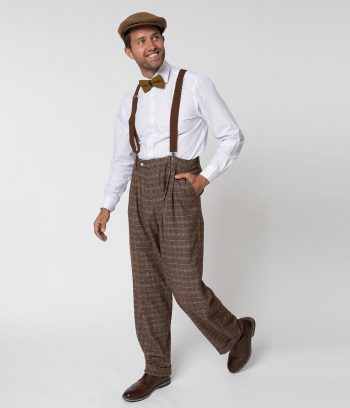
1930s Style Plaid High Waisted Trousers
Altogether, a 1930s man’s suit consisted of a Harris Tweed double breasted overcoat worn with a 3-piece single breasted suit with a mid-sized stripe or small cheviot pattern to it. A colored tie, cuffed pants, tan leather gloves, and a cane or umbrella accessorized the suit to business class formality.
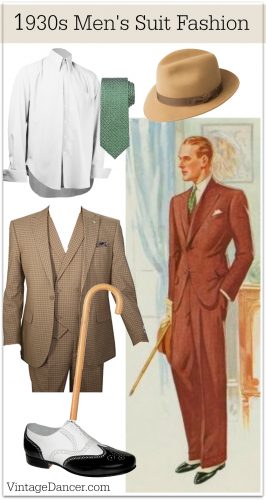
1930s Men’s Suit Outfit Idea- See This and More Men’s 1930s Clothing Ideas
1930s Summer Suits
Exchanging winter suits for summer suits in the past was very subtle. Only men who lived in or vacationed to tropical climates wore white suits, but in the 1930s, “summer whites” and tropical fabrics went mainstream from spring to early fall.
- The Blue Devils Saxophone Section Lester Young center with Theo Ross and Buster Smith in 1932
- Double breasted White Suit
Palm Beach Suits (a brand name as well as a general title for summer suits) made of a blend of cotton and mohair with an open weave featured single-breasted jackets (dark or light) with notch lapels. Other summer suit fabrics were seersucker, shantung silk, rayon blends, and linen. Tan gabardine was the preferred summer suit fabric for most middle-class men. It was heavier than the tropical fabrics, yet tailored well for a refined business suit. Gabardine trousers could pair equally as well with a polo shirt for a casual afternoon.
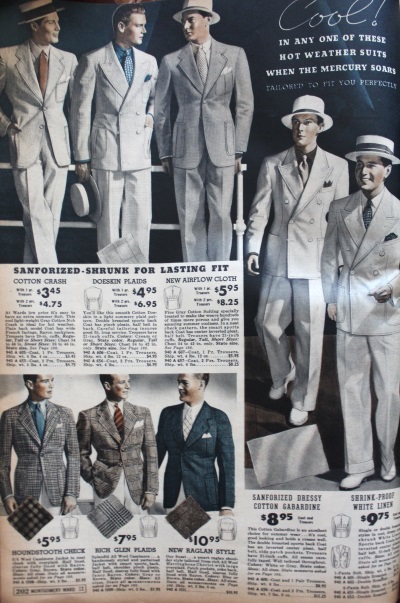
The 1930s Palm Beach Look, White on White
Stripe suits came in a variety of suit jacket styles with bold or faint lines, dot or fleck lines, thin chalk stripes, or shadowy chalk stripes. Choosing a stripe style was a matter of aesthetics. Thin stripes elongated a shorter man, while thicker stripes made a thin man appear less fragile. Everyone wanted the Superman look, and the right striped suit could help make that happen.
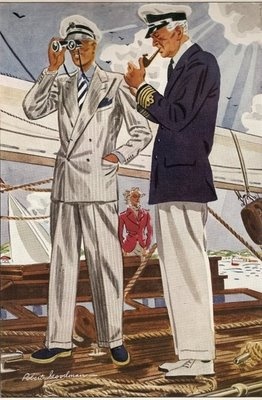
Summer “Yachting” Suit (R) and Striped Summer Suit (L)
Americans had a more casual take on summer fashion than their UK friends. Summer yachting or captain suits were mismatched sets of navy jackets were worn over white or ivory trousers. This is a fun look usually characterized by yacht or cruise passengers in the Golden Age of Hollywood movies.
Learn even more about men’s 1930s suits here or shop for men’s 1930s style suits here.
1930s Men’s Sport Coats
Men’s suit jackets could be made into sportier “sports coats” as well. Sports coats featured a sewn on belted back with pleats at the shoulder, belt, or both for ample movement. Sports coats came in more color choices than plain business suits. In the mid-’30s, gabardine coats came in a full range of golden tans, blues, browns, light grey, and ivory. Green and burgundy, although less common, added some more color to the earthy palette.
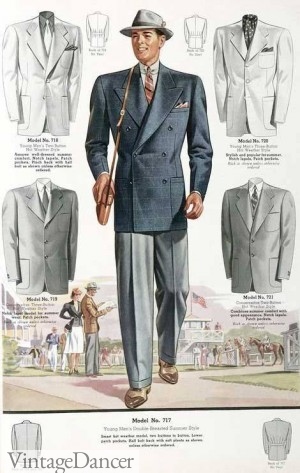
The 1930s Men’s Suit or Sportscoat
Each sports coat was paired with a matching or contrasting pair of trousers. For example: a tan coat with ivory pants, grey coat over brown pants, a blue coat over light grey pants. Textures, too, could be mixed, such as a tweed coat over a smooth gabardine pant.
The sports coat look was a bit too casual for British men to wear outside of the country, but for Americans it was becoming acceptable to wear to the office. It was also much more economical to mix and match coats and trousers, extending the life of one’s wardrobe. The happier colors, too, kept men’s spirits up, giving them the motivation to purchase even more new clothing.
- 1930s Windowpane Sport Coat, Blue Sweater Vest, Grey Pants, Fedora Hat
- 1930s Sporty Day Attire
Men’s Formal Suits
Very formal morning dress for upper-class men included a black or dark navy blue morning coat (or cutaway coat) with draped cut shoulders, tapered sleeves, peaked lapels, and (in America, but not in Britain) silk lapel facings. The suit was paired with solid grey, grey stripe, or herringbone print wide leg trousers; a white wingtip shirt; a white or buff morning vest; a dotted tie; a grey or black top hat; and white or grey gloves. It was reserved for upper society formal day time events, however it became too formal for most of the 1930s and quickly went out of fashion outside of weddings, which continued to take place in the morning.
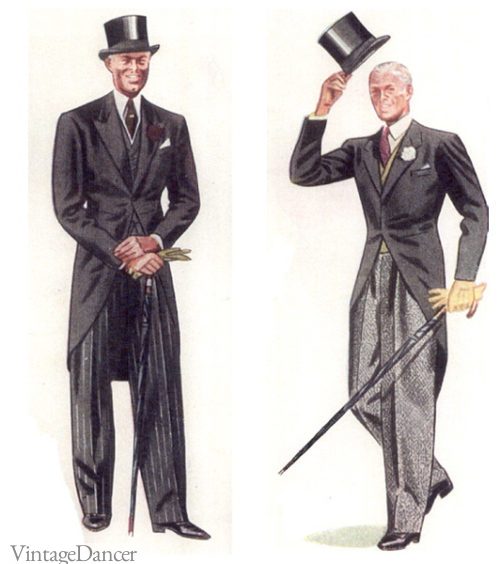
Two Formal Morning Suits
For men’s formal evening occasions (after 6pm), a black double-breasted 6 button dinner jacket (e.g. tuxedo jacket) with long broad pointed or peak lapels and square shoulders was a classic style. The dinner jacket cut was high on the thigh with straight vent-less tails. Dinner jackets could also come in dark colors such as a deep red jacket, and in single- and double-breasted styles. The white dinner jacket over black pants was also a new look in the 1930s, and one which screams Old Hollywood fashion.
Worn with black trousers, a black or white V-cut vest, a white button-down wingtip shirt, a black or white butterfly bow tie, a white pocket square, and black patent pumps, the 1930s tuxedo is and was the most traditional formalwear style.
- 1930s Clark Gable in Black Tie Formal Wear
- 1931 Dinner Jacket Tuxedo
- Men’s Tuxedo and Dinner Jacket
- 1930s White Tie Formalwear
For even more formal occasions, a thin fitting tailcoat paired with black satin-striped trousers was all the rage. Fred Astaire wore one dancing across the silver stage, and every man wanted to copy him.
Learn more about men’s 1930s tuxedos, wedding, and evening attire.
Men’s Dress Shirts and Ties
Dress shirts were not very different in the 1930s than they are today. Vertical stripes, windowpane, and small checks were the most common prints on almost any color ground imaginable. Common dress shirt colors were saturated green, mustard, blue, burgundy, brown, and grey as well as pastel yellow, rose-pink, ivory, peach, and white. Cotton broadcloth with drop stitching made up the bulk of men’s dress and casual shirts. The fad for thin satin striped dress shirts exploded in the late 1930s. All silk rich-hued dress shirts were also extremely popular, as was the cheaper rayon dress shirt.
Shirt cuffs were single button cuffs or double French cuffs for the very fancy dresser. Most dress shirts had a single chest pocket as well.
- 1935 Men’s Shirts
- 1936 Men’s Shirts in Summer Colors
- 1938 Men’s Cotton Dress Shirts and Ties
- 1937 Dress Shirts and Casual Shirts
Shirt collars were no longer stiff and detachable like they were in the early 1920s. Instead, soft attached spearpoint collars contrasted with the wide lapels of the suit. Spearpoints or arrow point collars were long and thin, ending in a sharp tip or point. Most collars were 3 or 3.25 inches long, but could extend down to 5 inches. Clark Gable wore the 4.5 to 5 inch California collar in a few of his movies. Other movie stars wore the wide Windsor collar with the wide knotted Windsor tie.
Shirt collars were prone to curling up, so many gentlemen turned to using gold collar pins to hold them down and keep the tie knot in place. Most collar pins were plain, but some fashioned “sporty” motifs for wearing in casual settings. Collar pins were eventually replaced by the button-down collar in the mid-1930s. The pinned collar and button-down collar were short or medium in length with somewhat wide spacing. A short rounded edge collar was popular between 1935 and 1938 when worn with a small knot four in hand tie.
Shop 1930s style men’s shirts here.
- 1933 Spearpoint Collar Shirt
- Cab Calloway Wears a Spearpoint Collar Shirt
Just as men’s dress shirts were colorful, so were the neckties. Multiple colors of horizontal stripes, plaids, checks, windowpane, small paisley, large dots, pin dots, argyle, and sports prints clashed with men’s shirts. It was a wild and colorful time in menswear. The hand-painted tie with Art Deco motifs became collector’s items then and now. New in the 1930s were handwoven wool ties made of textured fabrics like tweed bouclé, crochet silk, and twill. Both Windsor knot neckties and bow ties were worn with widespread collars- a trend started by the Duke of Windsor. Learn more about and shop for men’s ties here.
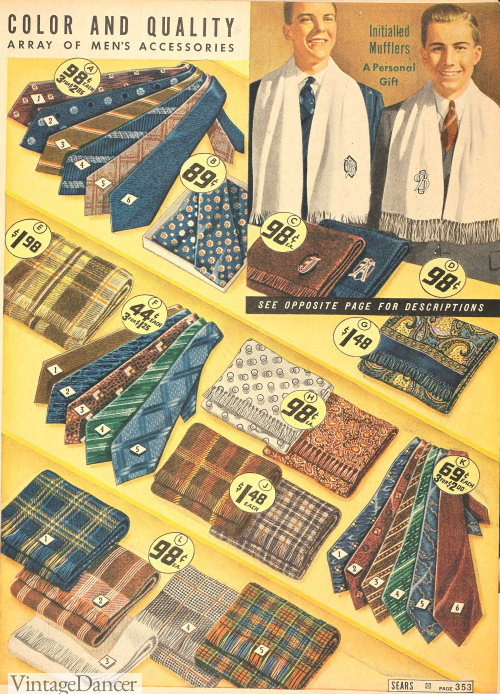
1938 Ties and Mufflers (Scarves)
The 1930s Gangster Style
1930s Gangsters / Mafia / Racketeering gentlemen all had a unique and bold style to their fashion. Striped double-breasted suits worn with monogrammed shirts were a must-have staple. Accessories such as charm bracelets, a signet ring, and grey felt fedoras with wide ribbon bands in almond, green, dove, lilac, petrol blue, brown, or dark grey identified just which mob a man was a part of. More can be found about 1920s-1930s Gangster styles here.
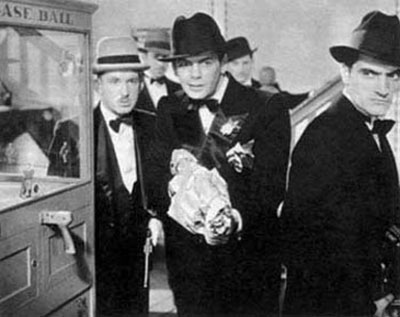
1936 Scarface Movie Gangsters
Men’s Coats
Initially, inspiration for men’s outerwear came from the British Grenadier’s greatcoat. The Americanized guard’s coat featured a shoulder line spread past the natural shoulder to line up with the bicep. Shoulder pads helped keep the angular shape. The coat then angled down to the waist, creating a V roll from neck to waist with a double breasted lap. Sleeves repeated the V shape by starting out very roomy at the shoulder and narrowing down to the wrist. Side slash pockets, peak lapels, and two pleats on the back side made this a new coat style for men in the 1930s.
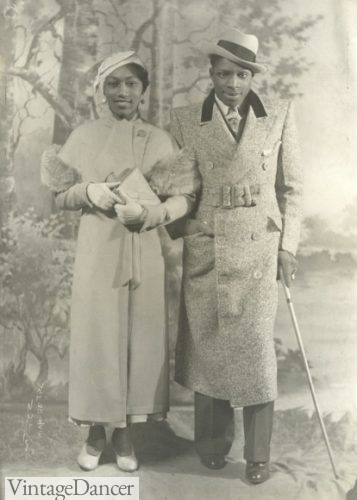
1935 Strolling Coats
The raglan sleeve coat in both single and double-breasted designs became very popular in the mid-1930s. Glen plaid, plaid over plaid, windowpane checks, and herringbone were on trend in the later half of the 1930s. Solid colors such as navy blue, grey, brown, and tan lined in printed fabric added to the mix. In winter, the rich could afford fur lining with fur collars and lapels, although many furs were cheaper rabbit skin instead of exotic pelts.
- 1934 Double Breasted Overcoat
- 1937 DB Overcoat
The camel hair top coat and tan wrapover overcoat were the young and wealthy man’s favorite. The wrapover was one of the few coats to come out of Hollywood instead of Britain. It was worn with an oversized collar flipped up around the neck, a full skirt, shorter length, and the tie wrapped loosely to one side. It was simple, carefree, and very movie star posh.
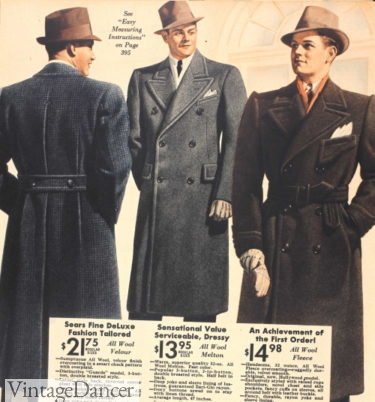
1937 Men’s Overcoats
The rainproof trench coat is the overcoat that the 1930s are most well known for. Detectives solved crimes wearing a tan, green or yellow (Dick Tracy) trench coat made of rubberized cotton or gabardine. The lightweight belted waist and large collars fit perfectly into the tough guy image of the thirties.
- Film Noir 1930s Detective Outfit
- 1934 Bulldog Drummond
Short coats such as the plaid Mackinaw as well as casual jackets (cossack, bomber) were often lined in sheepskin for warmth. Lighter weight jackets were worn for work and leisure outfits. All leather jackets were a wind proof option too.
- 1934 Casual Jackets and Mackinaw Coats
- 1934 Sport Coats and Mackinaw Coats
1930s Men’s Hats
The most common 1930s men’s hat was the fur felt or wool snap brim fedora. Fedoras came in light grey, dark grey, or brown with the occasional navy blue. 1930s fedoras featured a tall 5-6 inch crown with a deep center dent, optional pinch front, and a semi-wide 2-1/4 inch brim that shaped down in the front and slightly up in the back. The way the hat was shaped was largely up to the man and his haberdasher. Snap up, snap down, center dent, diamond-shaped, narrow dent? The variations were unlimited.
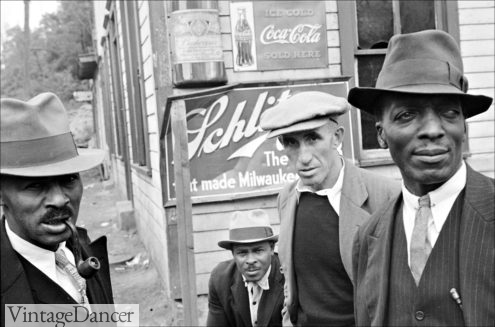
1935 Dressing in Sunday Best with Fedora Hats
Conservative businessmen preferred the dark gray, brown, midnight blue, or black Homburg over the fedora. A rolled brim with grosgrain edging and wide ribbon band with bow gave it a formal stately look. The black derby or bowler hat continued to be worn by some traditional men, but was mostly abandoned by middle classes.
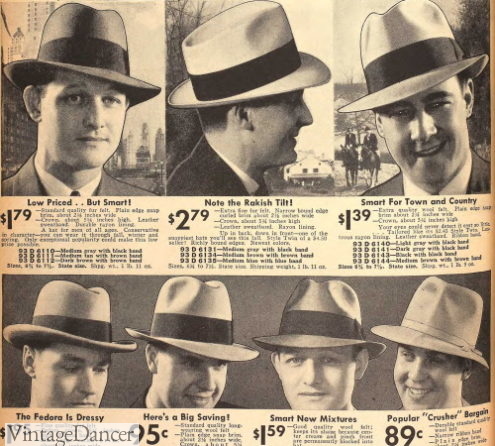
1936 Men’s Felt Hats – Fedoras and Homburgs
Straw hats in the same shape as felt hats were worn in late spring and summer. Colors ranged from tan to light grey, ivory, and white. The Optimo Panama, Longhorn, and Toyo continued to be favorites with vacationing upper classes. The round and flat top boater or sailor hat was a stylish hat for all classes in summer. It had a wide band with stripes matching a college, social club, or sport club’s colors.
The straw pork pie was the newest straw hat style with a low flat top and snapped-down brim all around in the first half of the decade, and a wider brim with the back snapped up in the later years. The trend of a suntan kept many more men out of hats in the summer than in previous years.
- 1934 Straw Hats
- 1932 Caps
Cloth caps were the most casual hat, worn for work or leisure. 8 panel caps with a short brim slimmed down slightly from the 1920s versions. A herringbone weave was the trendiest pattern.
Learn more about the history of 1930s men’s hats and shop 1930s style men’s hats here.
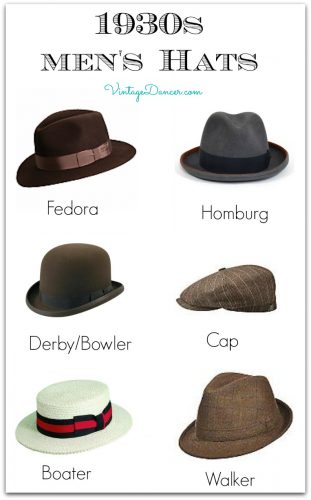
New 1930s Inspired Men’s Hats in Classic 30s Shapes
1930s Shoes and Socks
1930s men’s shoes continued in the tradition of the 1920s with classic cap toe Oxfords, two toned Oxfords, and wingtips with brogued detail (tiny holes punched in the leather). Black, brown, brown/cream, black/white, and grey/black usually matched men’s suits. In summer, white was the preferred shoe to wear with white or grey suits.
The shape of the toe box started out wide and square until 1935, when it rounded out into a point. Wingtips had the sharpest point. The trouser crease Oxford sported a center seam down the toe, elongating the toe box and counterbalancing wide-leg trousers.
The 1930s men’s shoe was much more decorated then the 1920s and 1940s with broguing, wingtips, side wings, contrast stitching, mesh, or weave all over the shoe body and toe.
- 1932 Men’s Two Tone Sport Shoes
- 1934 Men’s Basic Shoes and Boots
- 1935 classic Black, White, and Two-Tone Shoes
- 1936 Unique Types of Men’s Shoes
Lace-up boots were still worn by many older men and working classes.
Read more about 1930s men shoe styles. Shop 1930s style shoes for men.
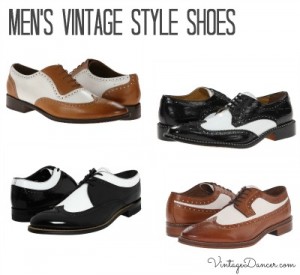
Vintage Style Men’s Shoes- Shop 30s Shoes
Silk socks in all sorts of colors and patterns emerged in the 1930s. Patterns of checks, plaid, and stripes were the most common, just like their suit counterparts. However, socks never had to match the suit. It was perfectly normal to wear bright green and blue check socks under a business grey suit! The influence of casual, colorful fashion affected everyone in whatever ways it could. More about men’s vintage socks here.
Read More
- 1930s Men’s Suits – History of men’s vintage 1930s suits and eveningwear
- 1930s Men’s Summer Suits – A guide to 1930s summer suit fashion
- 1930s Men’s Casual Fashion – How to dress on the weekends
- 1930s Workwear Clothing – 1930s men’s workwear and casual clothing history
- 1930s Men’s and Women’s Westernwear – A 1930-1950 history of western clothing
- 1930s Men’s Clothing Outfit Ideas – Put together one of these 1930s menswear outfits
- 1930s Men’s Shirts – Casual to dress shirts
- 1930s Men’s Trousers and Shorts
- 1930s Men’s Shoes – A brief look at the changes in men’s 1930s footwear
- 1930s Men’s Hats – Learn about and shop for 1930s men’s hats
- 1930s Men’s Ties – Read about tie history and shop for vintage or new 1930s pattern ties
- 1930s Men’s Swimwear – History of the 1930s, 1940s & 1950s swim trunks
- 1930’s Men’s Eyeglasses and Sunglasses
- 1930s Men’s Sewing Patterns – Vintage reproduction men’s sewing patterns from Victorian to 1960s
- Vintage Inspired Men’s Clothing – 1920s to 1960s men’s clothing retailers to shop from
- Watches – Read the history of men’s pocket watches and wrist watches.
- Gloves – The styles and etiquette of wearing men’s gloves.
- Jewelry – History of men’s collars pins, signet rings, cuff links and more
- Halloween Costumes – Costumes inspired by characters from the 1930s. Shop costumes.
Creating Your 1930s Look
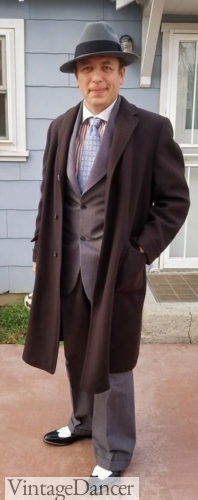
1930s Reproduction Suit with Inspired Overcoat, Fedora Hat, and Two-Tone Wingtip Shoes
Want to dress like a 1930s man? Vintage clothes can be hard to find, but well-chosen modern clothing can give you the same look and feel. We frequently dress in 1930s clothing for various themed events in our area, and we started out by shopping at thrift stores to save on money. Gradually, we replaced our wardrobe with higher quality and more accurate new classic men’s clothing. In the future, we hope to budget for a complete reproduction clothing set ($$$), but for now, we are very happy with our inspired looks.
Finding the proper wide shoulder, high waist, wide leg 1930s suit in used or new clothing is not going to be easy. We recently found a 1970s suit that is close (minus the bell bottom pants!), otherwise, we buy most of our clothes online.
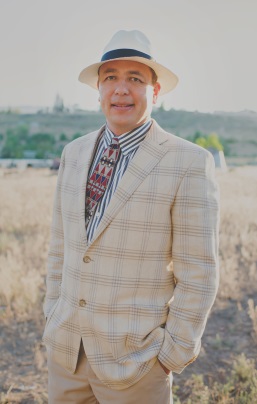
Oscar’s 1930s Summer Suit – Plaid Sport Coat and Striped Shirt over a Pair of Vintage Pants, Topped with a Straw Panama Hat
For example, the summer suit above is a mix of vintage and new clothing. The pants are 1950s vintage. A pair of classic fit pants (no skinny or low rise) with flat or pleated waist will work just as well. The sports coat is a windowpane plaid, single-breasted jacket from Paul Fredrick, which I then took to a tailor who added two layers of shoulder pads and took in the back to give it a more tailored fit with iconic 1930s broad shoulders (she called it the Athletic build fit). You certainly don’t have to go the extra mile with custom tailoring, but it can be done (and is worth it IMO). Most tailors won’t have a clue how to adjust for a 1930s suit, so bring in several pictures to help them. You may want to get a jacket one size up to allow room for the extra shoulder pads.
The striped shirt is new, geometric print tie is thrifted, and straw Panama hat is new. Not seen is the vintage ’50s two tone shoes.
Here are some other 1930s looks I have:
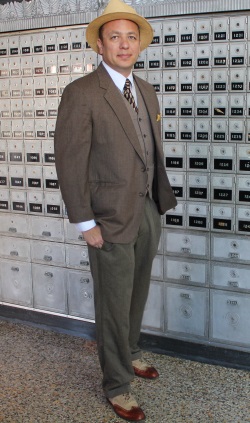
1930s Men’s Suit Fashion
This is a working class business men’s look, using entirely new (used) clothing. You may notice nothing matches. This was normal for the 1930s, since the Depression created a need for economy in men’s dress.
Brown single breasted suit coat with lighter brown 6 button vest, and a greenish pleated pant make up the suit. A plain white straight collar French cuff dress shirt and blue / navy / gold print tie coordinates with the gold pocket square (if your clothes can’t match, at least your accessories should). The final touches are two tone shoes and a straw fedora hat.
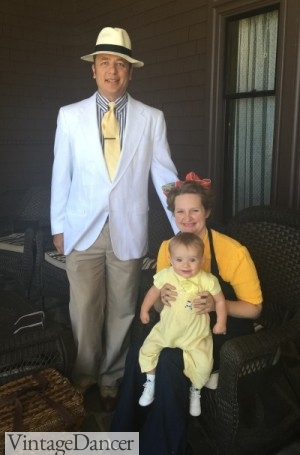
1930s Summer Whites
The next look was for a summer day at Lake Tahoe, so I wore my summer whites which consisted of a white dinner jacket (slightly too formal but where else can you get a white jacket?), tan pants, a blue striped shirt, gold tie, and straw Panama hat. A straw boater hat would have been another good hat to wear with this look.
1930s Men’s Outfits
See more 1930s men’s outfit ideas here and 30s clothing inspiration here. Also this review of car show outfits.
Now that YOU have the knowledge and some inspiration, go out there a create your very own 1930s inspired wardrobe. Use the links within this article and the 1930s menu above to put together your look. If you have any questions, please feel free to contact me anytime. Otherwise, happy shopping!
Debbie Sessions has been teaching fashion history and helping people dress for vintage themed events since 2009. She has turned a hobby into VintageDancer.com with hundreds of well researched articles and hand picked links to vintage inspired clothing online. She aims to make dressing accurately (or not) an affordable option for all. Oh, and she dances too.
